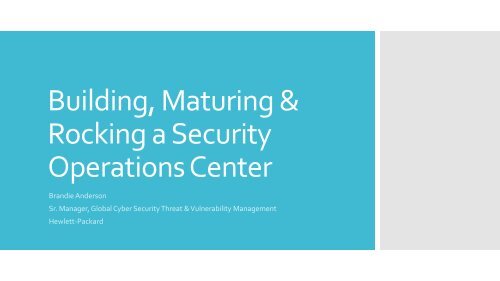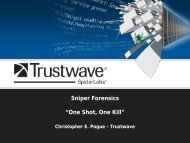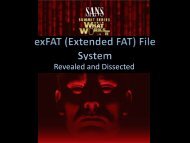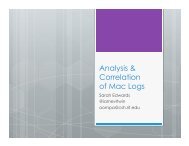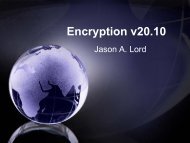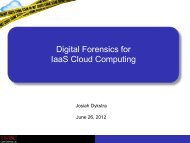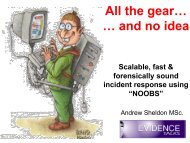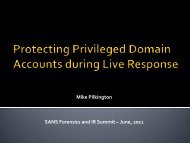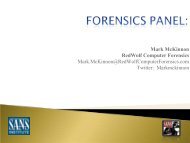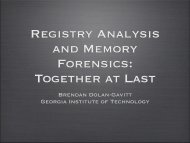Building, Maturing & Rocking a Security Operations Center - SANS ...
Building, Maturing & Rocking a Security Operations Center - SANS ...
Building, Maturing & Rocking a Security Operations Center - SANS ...
Create successful ePaper yourself
Turn your PDF publications into a flip-book with our unique Google optimized e-Paper software.
<strong>Building</strong>, <strong>Maturing</strong> &<br />
<strong>Rocking</strong> a <strong>Security</strong><br />
<strong>Operations</strong> <strong>Center</strong><br />
Brandie Anderson<br />
Sr. Manager, Global Cyber <strong>Security</strong> Threat & Vulnerability Management<br />
Hewlett-Packard
Agenda<br />
• To be or Not to be…<br />
• What is a SOC?<br />
• Use Case Creation<br />
• People<br />
• Process & Procedure<br />
• Documentation<br />
• Workflow<br />
• Metrics<br />
• I don’t want to grow up<br />
• <strong>Rocking</strong> a SOC<br />
• Questions<br />
2
To be or<br />
Not to be…<br />
• <strong>Building</strong> a SOC is a business decision<br />
• Organization size<br />
• Compliance factors<br />
• Reduce the impact of an incident<br />
• ROI<br />
• Proactive reaction<br />
3
Through people, processes and technology, a SOC is dedicated to<br />
detection, investigation, and response of log events triggered through<br />
security related correlation logic<br />
What is a SOC?<br />
4
ArcSight Correlation<br />
5
91% of Targeted Attacks Start<br />
with Spear-phishing Email<br />
Use Case<br />
Creation<br />
Large-Scale Water<br />
Holing Attack<br />
Campaigns Hitting<br />
Key Targets<br />
Microsoft's Patch Tuesday<br />
Leaves Out Crucial<br />
Internet Explorer Fix<br />
Adobe Data Breach Exposes<br />
Military Passwords<br />
6
People<br />
7
Roles and Responsibilities<br />
Level-1 and Level-2 Analysts<br />
<strong>Operations</strong> Lead<br />
Incident Handler<br />
SEIM Engineer<br />
Content Developer<br />
SOC Manager<br />
• <strong>Security</strong> Device Engineers<br />
• System Administrators<br />
• Network Administrators<br />
• Physical <strong>Security</strong><br />
Staffing Models<br />
Establishing coverage<br />
Determining the right number of resources<br />
8x5 = Min 2 Analyst w/ on-call<br />
12x5/7 = Min 4-5 Analysts w/on-call<br />
24x7 = Min 10-12 Analysts<br />
Finding the right skills<br />
Ensuring on-shift mentoring<br />
Continuous improvement<br />
Resource Planning<br />
8
Training<br />
Information security basics<br />
On-the-job training<br />
SEIM training<br />
<strong>SANS</strong> GCIA and GCIH<br />
Career development<br />
Avoiding burnout<br />
Providing challenges<br />
Outlining career progression<br />
Exactly how do I get from<br />
level 1 to level 2 to lead, etc<br />
Skill assessments<br />
Certifications<br />
9
Operational<br />
Analytical<br />
Business &<br />
Technology<br />
Process &<br />
Procedure<br />
• Call Out<br />
• Case Management<br />
• Event Handling<br />
• Monitoring<br />
• On-boarding<br />
• Shift Log<br />
• Shift Turn Over<br />
• Triage<br />
• Event Analysis<br />
• Incident<br />
Response<br />
• Reporting<br />
• Research<br />
• Threat<br />
Intelligence<br />
• Access<br />
Management<br />
• Architecture<br />
• Compliance<br />
• DR/BCP<br />
• Process<br />
Improvement<br />
• Use Cases<br />
10
Documentation<br />
Repository<br />
Choices<br />
Pro<br />
Pro<br />
Microsoft SharePoint<br />
• Approved by Policy<br />
• Already deployed, supported<br />
both internal & by Microsoft<br />
• Integrates with Active<br />
Directory & MS Office<br />
• Allows for Calendars, Task<br />
Assignment, Notifications,<br />
Document Revision Tracking<br />
Wiki<br />
Con<br />
• Open Source<br />
• Editor utilizes Markup<br />
Language (HTML-like)<br />
• Easy to Search<br />
• Malleable<br />
• Revision Control<br />
• Plugins allow extensive<br />
customization<br />
Con<br />
Complicated to use<br />
Typically hard to find information<br />
(search)<br />
Not very flexible<br />
No real revision<br />
File Shares<br />
control<br />
Pro<br />
• Everyone has MS Office<br />
Open Source<br />
Not Vendor supported<br />
Con<br />
• Everyone knows how to use a<br />
file share<br />
• Does not require specific<br />
technology knowledge<br />
• Cluttered<br />
• Overlap of information<br />
• Nearly impossible to search<br />
for information<br />
• Requires someone in charge<br />
of upkeep<br />
• No revision control<br />
11
Rule Fires<br />
Queued<br />
• Event<br />
• Incident<br />
Level 1 Triage<br />
Level 2<br />
Workflows<br />
• Case<br />
• SOC<br />
Level 1 Triage<br />
Investigating<br />
Level 2<br />
Investigating<br />
• Departmental<br />
• Organizational<br />
Engineering –<br />
Filter/Tuning<br />
Close Events<br />
Closed<br />
Incident Response<br />
or Ticket<br />
13
Metrics<br />
• How many events are coming in?<br />
• Raw Events<br />
• How many data endpoints are<br />
collected / monitored<br />
• How may different types of data<br />
• How many use cases<br />
• What is coming out?<br />
• Correlated Events<br />
• Incidents / Cases<br />
• How quickly are things handled?<br />
• Event recognition<br />
• Event escalation<br />
• Event resolution<br />
• Further defined<br />
• Per hour/day/week/month<br />
• Per analyst<br />
• Per hour of day/ per day of week<br />
• Incident / case category / severity<br />
14
• Understand the 80/20 rule<br />
• Leverage metrics<br />
• Expand senior leader dashboard view<br />
• Institute CMM methodology<br />
• Monitor organizational health<br />
• Increase complexity<br />
<strong>Maturing</strong><br />
15
According to the book Pragmatic <strong>Security</strong> Metrics – Applying Metametrics to Information <strong>Security</strong>*, an<br />
information security version of the Capability Maturity Model (CMM) looks loosely like this:<br />
“Level 1: Ad hoc: information security risks are handled on an entirely<br />
informational basis. Processes are undocumented and relatively unstable.<br />
Level 2: Repeatable but intuitive: there is an emerging appreciation of<br />
information security. <strong>Security</strong> processes are not formally documented,<br />
depending largely on employee’s knowledge and experience.<br />
CMM Example<br />
Level 3: Defined process: information security activities are formalized<br />
throughout the organization using policies, procedures, and security<br />
awareness.<br />
Level 4: Managed and measurable: information security activities are<br />
standardized using policies, procedures, defined and assigned roles and<br />
responsibilities, etc., and metrics are introduced for routing security<br />
operations and management purposes.<br />
Level 5: Optimized: Metrics are used to drive systematic information security<br />
improvements, including strategic activities.”<br />
*Brotby & Hinson, 2013 p. 47<br />
CMM – Capability Maturity Model is registered to Carnegie Mellon University<br />
16
Recovery<br />
Lessons<br />
Learned<br />
Eradication<br />
<strong>Rocking</strong> It<br />
Preparation<br />
Identification<br />
Containment<br />
17
Questions
Thank you!


